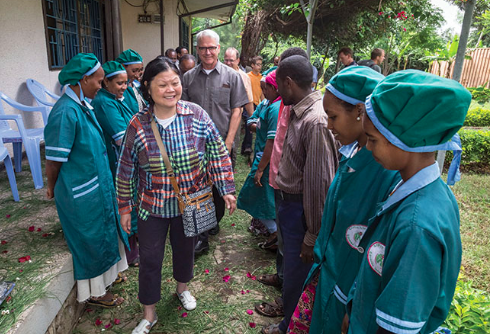Relief

I need a break from the head-spinning chaos of the sex abuse scandal, so I’ve decided to write about something in the church that works: the Catholic Relief Services (CRS). It – and I – were born in the same year, 1943, so we are celebrating 75 years together.
 The odd name “Relief” relates to the war during which we were both born, World War II. The American bishops wanted to assist refugees. Now emergency aid after disasters and for migrants is still a major focus of the organization.
The odd name “Relief” relates to the war during which we were both born, World War II. The American bishops wanted to assist refugees. Now emergency aid after disasters and for migrants is still a major focus of the organization.
The other two primary emphases are health care and economic development, especially in agriculture. Most of the organizations with which I have been familiar in Africa, for example, established schools during the colonial era. Because of its roots in wartime and postwar emergency aid, as it shifted its focus from Europe to the “developing world” in the 1950s CRS found its mission in providing material assistance to improve living conditions, what we used to call “Q of L,” quality of life. They elaborated “a theory of change” called Integral Human Development.
IHD, as found in Catholic social teaching, supports the ability of each individual to realize his or her full human potential in the context of just and peaceful relationships, a thriving environment and solidarity with others.
This is a theory of growth that accepts the reality of poverty and the way that better health and economic development can improve the lives of the very poor around the world. That’s what we all want.
The health focus is broad, though limited by its strict adherence to Catholic teaching. It includes treatment in health centers that also provide child care and health education. AIDS is a case in point. The epidemic has changed. Treating those with the illness with the drugs developed over the last twenty years suppresses the virus not only in the diseased person; it slows the spread. That is the approach in the CRS clinics: manage this disease that once devastated the continent of Africa. The incidence of new cases is slowing, but certainly not stopped, especially among women.
The CRS media people have fun with the agricultural focus. They describe fifteen women subsistence farmers using business babble: they are the engineer, the multi-tasker, the negotiator, the wonder woman, the dynamic duo – you get the picture. My favorite is the boss – a woman in Vietnam who leads a group who farm mangroves by boat. I saw rice fields there that looked just like this, and wonder if these mangroves prevent erosion in this marshy shoreline – a thought that occurs to me on this weekend of hurricane, in the news all the time.
You notice that these are all women. CRS has developed many programs to serve women through processes that involve local communities to identify needs. Women are often marginalized in traditional societies, but do much of the work. These projects allow them to work more effectively and often to create income for themselves and their families.

Carolyn Woo, then-CEO of CRS, visits the field office in Nazret, Ethiopia, in 2016. CNS photo/Petterik Wiggers, courtesy Catholic Relief Services
CRS is very Catholic. Supported by the American bishops and collections in parishes in the United States, CRS has a partnership with the National Council of Catholic Women, not WOC, for one possible example. But now 60% of its funding is from international governments and foundations.
The interests of WOC and CRS align. Dr. Carolyn Woo, president of CRS, was a main speaker at the third annual Voices of Faith event in the Vatican in 2015. While that year was not as dramatic as this year’s meeting outside the walls of the Vatican with Mary McAleese and others, it represented a point in the development of the Voices of Faith group, lifting up Catholic women working for women around the world.
So that’s my moment of relief. Next week I’ll write again about how the sex abuse scandal has caused many to look for new sources of lay leadership in a troubled church. CRS has proved its ability to grow and change with the times. May its leaders be models for those who need to change the structures of authority in the wider church.

2 Responses
Here’s Kate’s take on the 2015 Voices of Faith event from the Table in 2016. http://www.womensordination.org/blog/2016/03/09/voices-of-faith-2016-mercy-courage-and-a-hard-line/
Three years has meant a great deal of difference in VoF. CRS is still closely tied to official church policy.
For over 50 years, the Vatican has been misleading people about:
(1) The disciplinary cover-up of sexual abuse by clergy, saying that it is being managed.
(2) The doctrinal cover-up of the exclusively male priesthood, saying that it is dogmatic.
Both (1) and (2) are rooted in the conflation of patriarchal gender ideology and doctrines about human sexuality, so it is hard to imagine that issue (1) can be effectively resolved as long as issue (2) is not resolved. The Church is “one, holy, catholic, and apostolic,” but not necessarily patriarchal. For the redemption, and the sacramental economy, the masculinity of Jesus is as incidental as the color of his eyes. The Vatican should stop promoting patriarchal doctrines and allow Christ to call women to the priesthood and the episcopate. It is time to dismantle the patriarchal scaffolding that obscures the Catholic faith.
Some summary points for meditation:
http://pelicanweb.org/CCC.TOB.html#SUMMARY